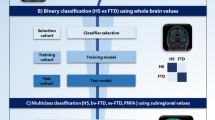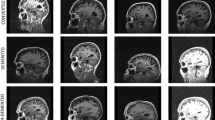Abstract
Purpose:
Frontotemporal lobe dementia (FTD) results from the degeneration of the frontal and temporal lobes. It can manifest in several different ways, leading to the definition of variants characterised by their distinctive symptomatologies. As these variants are detected based on their symptoms, it can be unclear if they represent different types of FTD or different symptomatological axes. The goal of this paper is to investigate this question with a constrained cohort of FTD patients in order to see if the heterogeneity within this cohort can be inferred from medical images rather than symptom severity measurements.
Methods:
An ensemble of convolutional neural networks (CNNs) is used to classify diffusion tensor images collected from two databases consisting of 72 patients with behavioural variant FTD and 120 healthy controls. FTD biomarkers were found using voxel-based analysis on the sensitivities of these CNNs. Sparse principal components analysis (sPCA) is then applied on the sensitivities arising from the patient cohort in order to identify the axes along which the patients express these biomarkers. Finally, this is correlated with their symptom severity measurements in order to interpret the clinical presentation of each axis.
Results:
The CNNs result in sensitivities and specificities between 83 and 92%. As expected, our analysis determines that all the robust biomarkers arise from the frontal and temporal lobes. sPCA identified four axes in terms of biomarker expression which are correlated with symptom severity measurements.
Conclusion:
Our analysis confirms that behavioural variant FTD is not a singular type or spectrum of FTD, but rather that it has multiple symptomatological axes that relate to distinct regions of the frontal and temporal lobes. This analysis suggests that medical images can be used to understand the heterogeneity of FTD patients and the underlying anatomical changes that lead to their different clinical presentations.





Similar content being viewed by others
Availability of data and materials
Data from the ECOCAPTURE dataset [12, 13] was collected by the Insitut du Cerveau (Paris, France). NIFD data are available at https://ida.loni.usc.edu, https://memory.ucsf.edu/research-trials/research/allftd.
References
Bang J, Spina S, Miller BL (2015) Frontotemporal dementia. Lancet 386(10004):1672–1682
Laforce R Jr (2013) Behavioral and language variants of frontotemporal dementia: a review of key symptoms. Clin Neurol Neurosurg 115(12):2405–2410
McCarthy J, Collins DL (2018) Ducharme S Morphometric mri as a diagnostic biomarker of frontotemporal dementia: a systematic review to determine clinical applicability. NeuroImage: Clin 20:685–696
Perry RJ, Graham A, Williams G, Rosen H, Erzinçlioglu S, Weiner M, Miller B, Hodges J (2006) Patterns of frontal lobe atrophy in frontotemporal dementia: a volumetric mri study. Dement Geriatr Cogn Disord 22(4):278–287
Peelle JE, Troiani V, Gee J, Moore P, McMillan C, Vesely L, Grossman M (2008) Sentence comprehension and voxel-based morphometry in progressive nonfluent aphasia, semantic dementia, and nonaphasic frontotemporal dementia. J Neurolinguist 21(5):418–432
Bouts MJRJ, Möller C, Hafkemeijer A, Swieten JC, Dopper E, Flier WM, Vrenken H, Wink AM, Pijnenburg YAL, Scheltens P, Barkhof F, Schouten TM, Vos F, Feis RA, Grond J, Rooij M, Rombouts SARB (2018) Single Subject Classification of Alzheimer’s Disease and Behavioral Variant Frontotemporal Dementia Using Anatomical, Diffusion Tensor, and Resting-State Functional Magnetic Resonance Imaging. J Alzheimers Dis 62(4):1827–1839
Feis RA, Bouts MJRJ, Panman JL, Jiskoot LC, Dopper EGP, Schouten TM, Vos F, Grond J, Swieten JC (2018) Rombouts SARB Single-subject classification of presymptomatic frontotemporal dementia mutation carriers using multimodal MRI. NeuroImage: Clin 20:188–196
Pellegrini E, Ballerini L, Hernandez MdCV, Chappell FM, González-Castro V, Anblagan D, Danso S, Muñoz-Maniega S, Job D, Pernet C, et al (2018) Machine learning of neuroimaging for assisted diagnosis of cognitive impairment and dementia: a systematic review. Alzheimer’s Dementia: Diagn Assess Disease Monitor 10:519–535
Ahmed MR, Zhang Y, Feng Z, Lo B, Inan OT, Liao H (2018) Neuroimaging and machine learning for dementia diagnosis: recent advancements and future prospects. IEEE Rev Biomed Eng 12:19–33
Estudillo-Romero A, Haegelen C, Jannin P (2022) Baxter JSH Voxel-based diktiometry: combining convolutional neural networks with voxel-based analysis and its application in diffusion tensor imaging for Parkinson’s disease. Human Brain Map** 1–17
Estudillo-Romero A, Migliaccio R, Batrancourt B, Jannin P, Baxter JS (2024) Non-local diffusion-based biomarkers in patients with cocaine use disorder. Neuroimage: Rep 4(2):100202
Tanguy D, Batrancourt B, Estudillo-Romero A, Baxter JSH, Le Ber I, Bouzigues A, Godefroy V, Funkiewiez A, Chamayou C, Volle E, Saracino D, Rametti-Lacroux A, Morandi X, Jannin P, Levy R, Migliaccio R (2022) An ecological approach to identify distinct neural correlates of disinhibition in frontotemporal dementia. NeuroImage: Clin 35:103079
Godefroy V, Levy R, Bouzigues A, Rametti-Lacroux A, Migliaccio R, Batrancourt B (2021) Ecocapture@ home: protocol for the remote assessment of apathy and its everyday-life consequences. Int J Environ Res Public Health 18(15):7824
Olney NT, Ong E, Goh SM, Bajorek L, Dever R, Staffaroni AM, Cobigo Y, Bock M, Chiang K, Ljubenkov P, Kornak J, Heuer HW, Wang P, Rascovsky K, Wolf A, Appleby B, Bove J, Bordelon Y, Brannelly P, Brushaber D, Caso C, Coppola G, Dickerson BC, Dickinson S, Domoto-Reilly K, Faber K, Ferrall J, Fields J, Fishman A, Fong J, Foroud T, Forsberg LK, Gearhart DJ, Ghazanfari B, Ghoshal N, Goldman J, Graff-Radford J, Graff-Radford NR, Grant I, Grossman M, Haley D, Hsiung G, Huey ED, Irwin DJ, Jones DT, Kantarci K, Karydas AM, Kaufer D, Kerwin D, Knopman DS, Kramer JH, Kraft R, Kremers W, Kukull W, Lapid MI, Litvan I, Mackenzie IR, Maldonado M, Manoochehri M, McGinnis SM, McKinley EC, Mendez MF, Miller BL, Onyike C, Pantelyat A, Pearlman R, Petrucelli L, Potter M, Rademakers R, Ramos EM, Rankin KP, Roberson ED, Rogalski E, Sengdy P, Shaw LM, Syrjanen J, Tartaglia MC, Tatton N, Taylor J, Toga A, Trojanowski JQ, Weintraub S, Wong B, Wszolek Z, Boxer AL, Boeve BF, Rosen HJ (2020) on behalf of the ARTFL and LEFFTDS consortia: clinical and volumetric changes with increasing functional impairment in familial frontotemporal lobar degeneration. Alzheimer’s Dementia 16(1):49–59
Descoteaux M, Wiest-Daesslé N, Prima S, Barillot C, Deriche R (2008) Impact of rician adapted non-local means filtering on hardi. In: Metaxas D, Axel L, Fichtinger G, Székely G (eds) Medical Image Computing and Computer-Assisted Intervention - MICCAI 2008. Springer, Berlin, Heidelberg, pp 122–130
Tustison NJ, Avants BB, Cook PA, Zheng Y, Egan A, Yushkevich PA, Gee JC (2010) N4itk: improved n3 bias correction. IEEE Trans Med Imaging 29(6):1310–1320
Tournier J-D, Smith R, Raffelt D, Tabbara R, Dhollander T, Pietsch M, Christiaens D, Jeurissen B, Yeh C-H, Connelly A (2019) MRtrix3: a fast, flexible and open software framework for medical image processing and visualisation. Neuroimage 202:116137
Andersson JLR (2016) Sotiropoulos SN An integrated approach to correction for off-resonance effects and subject movement in diffusion MR imaging. NeuroImage 125(C):1063–1078
Norton I, Essayed WI, Zhang F, Pujol S, Yarmarkovich A, Golby AJ, Kindlmann G, Wassermann D, Estepar RSJ, Rathi Y, Pieper S, Kikinis R, Johnson HJ, Westin C-F, O’Donnell LJ (2017) SlicerDMRI: open source diffusion MRI software for brain cancer research. Can Res 77(21):101-103
Avants B, Epstein C, Grossman M, Gee J (2008) Symmetric diffeomorphic image registration with cross-correlation: evaluating automated labeling of elderly and neurodegenerative brain. Med Image Anal 12(1):26–41
Avants BB, Tustison NJ, Song G, Cook PA, Klein A, Gee JC (2011) A reproducible evaluation of ANTs similarity metric performance in brain image registration. Neuroimage 54(3):2033–2044
Fonov V, Evans A, McKinstry R, Almli C, Collins D (2009) Unbiased nonlinear average age-appropriate brain templates from birth to adulthood. NeuroImage 47:102. Organization for Human Brain Map** 2009 Annual Meeting
Zou H, Hastie T, Tibshirani R (2006) Sparse principal component analysis. J Comput Graph Stat 15(2):265–286
Agosta F, Scola E, Canu E, Marcone A, Magnani G, Sarro L, Copetti M, Caso F, Cerami C, Comi G et al (2012) White matter damage in frontotemporal lobar degeneration spectrum. Cereb Cortex 22(12):2705–2714
Lam BY, Halliday GM, Irish M, Hodges JR, Piguet O (2014) Longitudinal white matter changes in frontotemporal dementia subtypes. Hum Brain Mapp 35(7):3547–3557
Rajagopalan V, Pioro EP (2014) Distinct patterns of cortical atrophy in als patients with or without dementia: an mri vbm study. Amyotrophic Lateral Sclerosis Frontotemporal Degeneration 15(3–4):216–225
Lee SE, Rabinovici GD, Mayo MC, Wilson SM, Seeley WW, DeArmond SJ, Huang EJ, Trojanowski JQ, Growdon ME, Jang JY et al (2011) Clinicopathological correlations in corticobasal degeneration. Ann Neurol 70(2):327–340
Funding
Alfonso Estudillo Romero is supported through the SAD Région Bretagne programme and the Institut des Neurosciences Cliniques de Rennes (INCR).
Author information
Authors and Affiliations
Corresponding author
Ethics declarations
Conflict of interest
The authors have no Conflict of interest to declare.
Ethics approval
All ECOCAPTURE data were collected with institutional ethics board approval (Clinicaltrials.gov:NTC02496312, NCT03272230).
Additional information
Publisher's Note
Springer Nature remains neutral with regard to jurisdictional claims in published maps and institutional affiliations.
Rights and permissions
Springer Nature or its licensor (e.g. a society or other partner) holds exclusive rights to this article under a publishing agreement with the author(s) or other rightsholder(s); author self-archiving of the accepted manuscript version of this article is solely governed by the terms of such publishing agreement and applicable law.
About this article
Cite this article
Estudillo Romero, A., Migliaccio, R., Batrancourt, B. et al. Analysis of convolutional neural networks for fronto-temporal dementia biomarker discovery. Int J CARS (2024). https://doi.org/10.1007/s11548-024-03197-w
Received:
Accepted:
Published:
DOI: https://doi.org/10.1007/s11548-024-03197-w




